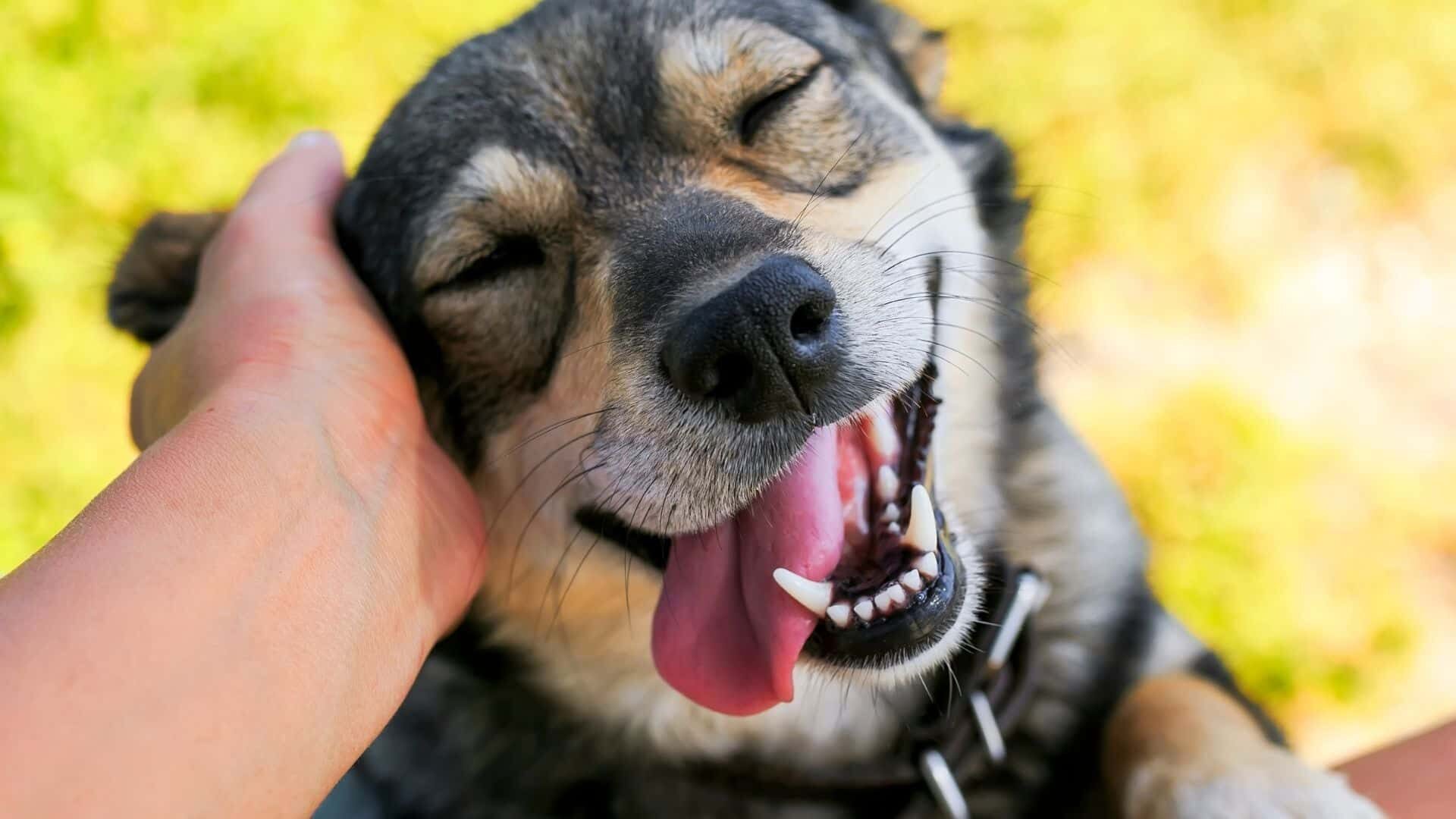It’s heartbreaking to watch your beloved furry pals suffer, especially when they’re close to their natural death. Do dogs, on the other hand, understand that they are going to die? This is a human existential question, and neither we nor our canine companions have all the answers to it.
It’s possible that dogs are aware of certain things, but it’s also vital to understand how humans can aid if they’re nearing the end of their lives.
It’s tough for any dog owner to learn how to spot the usual indicators of a dying dog, but it’s critical for anyone who has a dog who is ageing or has a fatal condition to learn how to do so.
The sad truth is that our dogs do not live indefinitely. The lifespan of a dog is influenced by a variety of factors, including its breed, size, environment, and genetics.
We owe it to our pets to understand more about the natural death process because they have brought us so much happiness for so long.
Is it possible that dogs have a sense of when they are going to die?

We may assume we know what a dog’s thinking based on how they respond to our affection—or smother us with it! In recent years, researchers have been intrigued by the idea of finding ways to improve our bond with our canine friends.
According to neuroscientist Gregory Berns, author of the best-selling book What It’s Like to Be a Dog, some dogs love to play fetch while others do not. If they don’t want to play, does that suggest that they don’t understand the cue?
Berns penned the following: “A human explanation for the dog’s behaviour is too easy to anthropomorphize. There is no such thing as a generic dog, thus generalisations concerning dog discoveries should be avoided. There is no such thing as a “generic” human.” We can learn a lot about our pets’ feelings by their behaviour, according to Berns, because dogs can’t speak.
Daily Paws health and behaviour specialist Haylee Bergeland, CPDT-KA, CBCC-KA, RBT, is also the founder and executive director of the Iowa Human-Animal Bond Society. According to her, it’s difficult to tell how much a dog understands or feels as they near the end of their lives, although certain actions may be more obvious.
When it comes to dog behaviour, “many dogs appear to be more ‘clingy’ or connected,” Bergeland adds. “They follow you around continuously and stay close.” They “seem to withdraw themselves and crave solitude more than they normally would,” says a dog trainer.
Aside from the increased whimpering and barking, she’s also noticed some dogs “become calm and still—as if they have a want to spend some energy, but simply can’t quite accomplish it,” she tells the New York Times.
Others, including academics and veterinarians, rely on “citizen science,” a joint effort between the general public and professional scientists to investigate the natural world, in order to discover how canines know when they’re about to die. Due to our heightened awareness of their requirements, we naturally assume that our dogs are aware of what is taking place around them.
Do dogs know when they are about to die?
Being sick is something we can all identify with, from the throbbing headaches and nausea to the bizarre sense of “hair hurting,” weariness, a lack of desire for food, and so on. Dogs’ behaviour is the only way we can tell if they’ve been affected by most of these.
Even if they are shown attention, preferred activities, or treats, they are less- or unresponsive.
Aside from other clinical indicators that a veterinarian is aware of, all of these were frequently seen in dogs who were nearing death. Symptoms of all of these disorders can also emerge in otherwise healthy young dogs who eat something they shouldn’t or who get the canine version of the common cold.
When a dog is sick, like humans, they may try to locate a safe place to rest. Depending on who you ask, that may be a familiar spot to sleep, but for others it may be a new and strange place. Although the dog-hiding trope isn’t entirely accurate, it isn’t fully incorrect either; they do appear to go somewhere new, removed, even hidden, often. On the other hand, this isn’t always the case.
During a euthanasia, dogs have no idea what’s going on: they don’t know that “they’re alive” or that death “exists,” and they don’t know about needles or medicine or chemistry or time. They don’t respond at all.” Our sobs, hugs, and other displays of raw emotion do elicit reactions from them on occasion. Their owners would tell us that once in a while they’d wag their tails for the first time in a long time as they hugged them farewell.
An injured dog’s death can be more complicated due to the presence of pain and fear, as well as functional deficits that might lead to mayhem (e.g., they can’t regulate their faeces, are bleeding profusely, or have been run over).
How to recognize dog’s natural death?

It’s critical to understand that dogs, like humans, go through a long period of dying before they die.
As a result, the process of dying begins well before the moment of death, and each person’s experience is unique. In the same way that each dog is an individual, so too is the process of death for each of them.
In the absence of a quick death like poisoning or an acute infection, owners often experience sadness while their dogs undergo a variety of physical, behavioural, and psychological changes as they transition from this world to the hereafter.
How do you know when your dog is about to die?
It is painful to watch a pet’s death take place, but it is best to know what is going on. The fact that death is a gradual process means that dog owners can take a number of proactive efforts to help their pets cope with the transition.
Early indicators of death in dogs are summarised in the following paragraphs. Even in dogs who are just a few days away from death, these common indications begin to appear months to weeks before death.
The death of an elderly or sick dog might occur unexpectedly and without warning in rare situations. Some people die suddenly, while in others, death creeps up on them gradually, leaving behind telltale symptoms. The natural death of a dog is how long? No one dog’s circumstance is the same, thus there is no defined timetable. The following symptoms, according to Leesville Animal Hospital, may be present:
As the digestive system begins to malfunction, nausea, vomiting, and diarrhoea are common side effects.
Bloody urination may occur without warning.
Consciousness loss – A dog may have slept a lot and woken up briefly before this stage. During the final stages of life, they may lose consciousness for a few minutes or even hours.
As the gap between breaths lengthens, so does the rate at which one breathes. After the dog loses consciousness, the dog’s breaths may be several minutes apart.
As muscle function diminishes, so does the heart rate, which slows down with time.
Reflexes and the sensation of pain will diminish as a result of decreased muscle spasms and twitching.
What signs show that your dog is dying?
1. Pain and discomfort
End-of-life symptoms including pain and discomfort are prevalent in dogs.
You may experience the following indicators of discomfort:
- Hiding
- Trembling
- Panting
- Impairment of movement
- Resentment toward members of one’s own family
- Irritability
- Restlessness
- Aggression
It’s possible that your dog will have difficulty settling down and resting if he’s stressed. Sleeping excessively or seeking out different resting locations for comfort may be a problem for some dogs.
2. Lethargy
As dog owners, we’re accustomed to seeing our dogs constantly on the go, so when they suddenly seem sluggish, we get concerned. Abbreviated as ADR in medical records, the term “ain’t doing right” is used to describe irregular behaviour in a dog that isn’t doing well.
It is important to note that lethargy in dogs does not necessarily mean that they are dying or that they are suffering from a terrible illness, but it can be one of the first symptoms of a more serious sickness or the beginning stages of death.
3. Excessive loss of weight
Senior dogs frequently lose weight, and it usually begins long before the animal’s death. As the dog ages, his body becomes less effective at digesting protein, causing him to lose muscular mass. This is natural. This process can be slowed down by increasing the amount of protein in the diet.
Sickness can also lead to weight loss, either as a result of decreased hunger brought on by the illness itself or as a result of the additional stress the body is under. Extreme weight loss in cancer patients is a symptom known as cachexia. When your dog’s cancer cells multiply and spread, they demand a lot of your dog’s fat and muscle stores, which might lead to the disintegration of these resources.
It’s common for dogs to lose weight even if they’re eating a full meal, even as they get older or worse.
4. Eats/drinks nothing
When your dog refuses to eat, you know something is wrong, and this is one of the most common indicators that a dog is dying. The tastiest treat in the world will not entice your dog if they are at this stage. As a result, they’ll cease taking in liquids altogether. This is because their organs are starting to shut down.
As a result, they no longer feel hungry or thirsty. Give them water in a dropper or turkey baster to try and keep them hydrated. Unless they’ll take it, there’s little you can do about it. A dog may stop eating and drinking for a few days, but this does not mean they are terminally ill. A trip to your veterinarian is a good place to start to make sure there aren’t any additional problems.
5. Favorite activities aren’t enticing the dog any longer
A dog’s enthusiasm in their favorite pastimes may begin to wane as their health deteriorates. It’s possible that some dogs will retreat and cease associating with their family, while others may become overly clinging and desperate for attention. As a result, you may notice that your dog seems drowsy and melancholy, or that they just don’t seem like their normal selves.
6. Incontinence and a loss of personal hygiene
At the end of their lives, some pets lose control of their bladder and bowels and become incontinent. In certain cases, pets are unable to get out of their beds to relieve themselves and may require further assistance from their owners or families. Due to a lack of proper cleanliness and grooming, your dog’s coat may appear unkempt.
7. A lack of cohesion
Your dog’s muscles and nerves begin to deteriorate as he ages, making it more difficult for him to walk. His coordination will deteriorate due to the decrease of muscular mass and the dysfunction of proprioceptive neurons.
On non-carpeted surfaces, such as sidewalks and driveways, his mobility may be impaired. Walking might be difficult for some dogs because they trip or misplace their feet. Typically, these symptoms develop over time, starting out as infrequent but gradually becoming more regular and severe bumbles. Muscle twitching may occur involuntarily in some dogs as well.
In order to help your dog, you can provide non-slip surfaces for him to walk on and support him while walking and going outdoors for a potty break. Assist in case he falls off of a narrow ramp if he loses his balance. Ramps are useful for negotiating stairs and getting on and off of furniture.
Watch How to know if your dog is going to die | Video
How long does it take for a dog to pass away?
Natural death in a dog occurs at any time. The deterioration of certain dogs is so rapid that they can die within a few hours. It may take days or weeks for other canines to appear to be dying before the actual demise occurs.
Is a dog aware of his own death?
They are a source of solace not only at times of loss, but also in times of depression, loss of employment, or even a cross-country move. Experts believe that dogs may detect death or grief in humans through nonverbal clues such as body language and odours that only they can notice.
When a dog is dying, how do they react?
A restless dog is one who is unable to settle down or find a comfortable spot in the house. It’s possible that some people will become extremely docile and even unresponsive. It’s possible that your dog’s sleep schedule will shift. Due to discomfort or disorientation, he may become abrasive and difficult to deal with.
Is it preferable for dogs to be alone when they die?
Not at all; aged dogs do not deliberately abandon their owners so that they might die alone. Senior dogs are known for wandering off and eventually being found dead, yet this is not the dog’s preferred method of departure.
What can I do to ease my dog’s passing?
When a Dog Is Dying, what to Do?
Be calm and patient.
Ensure a peaceful working environment.
Speak in a way that is reassuring.
Make sure they have a good night’s sleep.
Keep a supply of fresh water on hand.
If they are able to eat, serve them their favourite foods.
Only administer painkillers prescribed by the veterinarian if necessary.
Hug and pet them as much as you can.
Conclusion

While pet loss is painful, it can be alleviated if you recognise the telltale signals of a dog’s impending doom. In order to ascertain the severity of your dog’s disease, get your dog evaluated by your veterinarian.
These symptoms can occur with a variety of health issues. If you’re aware of the warning signals, you’ll be able to take steps to make sure your dog’s final days with you are filled with light and love.






